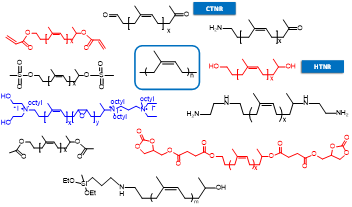Institut des Molécules et Matériaux du Mans
Avenue Olivier Messiaen, 72085, Le Mans, France
Phone: + 33 (0)2 43 83 33 35
E-mail: pamela.pasetto @ univ-lemans.fr (pamela.pasetto @ univ-lemans.fr)
Abstract
The expertise of the team has been exploited to obtain telechelic functional oligomers from the controlled breaking of polyisoprene chains in natural rubber. Thin and thick cross-linked films based on such oligomers have been prepared with antibacterial properties inferred by tailor-made monomers. New oligomers have been synthesized for covalent grafting to different surfaces in order to make smart composite materials. Ongoing studies will be presented about the preparation of hybrid particles with polyisoprene shell and synthetic or bio-silica core.

Figure 1. Non-exhaustive portfolio of oligomers issued from natural rubber used in the preparation of new materials.
Natural rubber (NR) represents an excellent example of bio-based material having the necessary high elasticity, mechanical strength, fatigue resistance, wide range of operating temperatures, and tear strength together. NR is constituted by polyisoprene chains with cis-1,4-carbon-carbon double bonds and in most of the applications it is normally used as produced by the Hevea brasiliensis trees, without breaking the polymer chain, but only modifying the backbone (for instance by vulcanization). Conversely, in our team, functional oligoisoprenes, natural rubber oligomers (NRO), have been obtained by breaking the polymer chains with a relatively simple and easy to scale-up technology[1]. The so obtained tailor-made NRO can be modified at the chain ends to insert different chemical groups and become the building blocks for the preparation of thin and thick coatings, foams, and composite materials (Fig.1).
The results of a research work concerning the synthesis of new elastomeric materials based on natural rubber derived building blocks and organic monomers having antifouling and/or antibacterial properties, covalently bound to the polymer network will be presented. Original acrylate monomers bearing an organic bioactive moiety (a Guanidinium group or Zosteric acid derivates) were synthesized and co-polymerized with telechelic acrylate oligomers from polyisoprene. No significant leaching of the bioactive monomers occurred and the material resisted to long water immersions. Freestanding films prepared from acrylate oligoisoprenes also showed a weak antibiofouling activity, which was drastically increased by integrating the guanidinium and the Zosteric acid monomers. The coatings were active against several strains of pathogenic bacteria among which Pseudomonas aeruginosa, Staphylococcus aureus, Bacillus subtilis and Staphylococcus epidermidis. In order to covalently graft oligoisoprenes to surfaces, new bifunctional oligoisoprenes bearing an alkoxy-silane end moiety were designed and coupled with silicon-containing materials. An alternative approach was followed by prefunctionalizing the surface with amino groups and by covalently grafting oligomers with carbonyl chain-ends. Post-polymerization from the surface free chain-ends resulted in a thick oligoisoprene coating with strong resistance to solvent immersion (water, THF). In this way, we were able to build dense and tethered molecular layers, thin films and thick coatings.
The aim of the second research axis that will be presented is to exploit diatoms for the generation of new hybrid particles by functionalization with polymer brushes. The objective is to develop a methodology using model microalgae and polymers in order to propose a general approach that could be successively applied to other diatoms with a different size, and morphology, and using other polymers. Silica particles are involved in numerous industrial applications concerning products used in everyday life. The problem is that silica is mainly obtained from sand or quartz and the sand shortage is a global environmental problem. To give a contribution to this issue, it is proposed to rescue the waste silica skeletons of microalgae cultivated in photobioreactors for other purposes and exploit them as inorganic cores in composite nanoparticles to be used in niche applications. As model microalgae, the marine diatom Haslea Ostrearia will be used because its production is currently scaled up to extract high value compounds such as pigments and proteins. The biomass provided by the biologists colleagues in Le Mans has been cleared of the organic matter and NRO have been tethered to the silica surfaces using different strategies in preliminary tests. The so obtained hydrophobic hybrid particles have been inserted in polyisoprene matrices to give charged films. This type of core-shell particles is interesting for industrials working in the field of elastomers, to solve the problem of rubber reinforcement with hydrophilic inorganic charges, which are required to ensure mechanical properties but are generally difficult to incorporate homogenously.
[1] a) J.Appl.Polym.Sci., 2003, 87 (1), 42. b) Int. J. Mol. Sci., 2015, 16 (3), 4392-4415. c) Patent WO2010043800A1. Photocrosslinkable antifouling functionalized oligoisoprene-based compositions, coatings obtained from these compositions and corresponding uses.